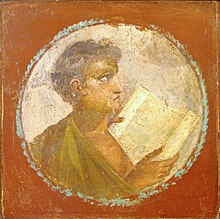Rotulus: Difference between revisions
Content deleted Content added
remove {{Cleanup|date=August 2010}} |
No edit summary |
||
| Line 9: | Line 9: | ||
*Specific legal records in [[Europe]], from which is still derived the title of the judicial functionary denominated the "[[Master of the Rolls]]", and the [[Byzantine Empire]];<ref name="daly">{{cite journal|last1=Daly|first1=Lloyd W.|title=Rotuli: Liturgy Rolls and Formal Documents|journal=Greek, Roman and Byzantine Studies|date=1973|volume=14|issue=3|publisher=Duke University|url=http://grbs.library.duke.edu/article/viewFile/9191/4607}}</ref> |
*Specific legal records in [[Europe]], from which is still derived the title of the judicial functionary denominated the "[[Master of the Rolls]]", and the [[Byzantine Empire]];<ref name="daly">{{cite journal|last1=Daly|first1=Lloyd W.|title=Rotuli: Liturgy Rolls and Formal Documents|journal=Greek, Roman and Byzantine Studies|date=1973|volume=14|issue=3|publisher=Duke University|url=http://grbs.library.duke.edu/article/viewFile/9191/4607}}</ref> |
||
*Liturgical manuscripts, e. |
*Liturgical manuscripts, e.g., those used for [[chant|chanting]] the ''[[Exultet]]''; and |
||
*Especially [[mortuary roll|mortuary rolls]], i. |
*Especially [[mortuary roll|mortuary rolls]], i.e., documents memorializing the names of all the deceased members of a [[monastery]] or other institution, which were banded together and circulated so that they could mutually pray for the repose of each other's decedents.<ref name="daly"/> |
||
[[Image:Scroll.jpg|right|thumb|Scroll, which writes perpendicular to the way it is done in a rotulus, of the [[Book of Esther]] from [[Seville]], [[Spain]].]] |
[[Image:Scroll.jpg|right|thumb|Scroll, which writes perpendicular to the way it is done in a rotulus, of the [[Book of Esther]] from [[Seville]], [[Spain]].]] |
||
Revision as of 16:21, 5 June 2019
This article has multiple issues. Please help improve it or discuss these issues on the talk page. (Learn how and when to remove these template messages)
|

A rotulus (plural: rotuli) is a kind of roll consisting of a long and narrow strip of writing material, historically papyrus or parchment, that is wound around a wooden axle or rod and is written on its interior face or side[1] such that it is unwound vertically so that the writing runs parallel to the rod,[2] unlike the other kind of roll, namely the "scroll", whose writing runs perpendicular to the rod in multiple columns.
Rotuli were historically used for:
- Specific legal records in Europe, from which is still derived the title of the judicial functionary denominated the "Master of the Rolls", and the Byzantine Empire;[3]
- Liturgical manuscripts, e.g., those used for chanting the Exultet; and
- Especially mortuary rolls, i.e., documents memorializing the names of all the deceased members of a monastery or other institution, which were banded together and circulated so that they could mutually pray for the repose of each other's decedents.[3]

References
- ^ Grout, James. "Scroll and Codex". Encyclopaedia Romana.
- ^ "What's On?: From Roll to Codex". Bodleian Libraries. University of Oxford.
- ^ a b Daly, Lloyd W. (1973). "Rotuli: Liturgy Rolls and Formal Documents". Greek, Roman and Byzantine Studies. 14 (3). Duke University.
- Attribution
 This article incorporates text from a publication now in the public domain: Herbermann, Charles, ed. (1913). "Rotuli". Catholic Encyclopedia. New York: Robert Appleton Company. The entry cites:
This article incorporates text from a publication now in the public domain: Herbermann, Charles, ed. (1913). "Rotuli". Catholic Encyclopedia. New York: Robert Appleton Company. The entry cites:
- Léopold Victor Delisle, Rouleaux des morts du IX au XV siecle (Paris, 1866);
- ____, in Bibl. de l'ecole des Chartes, series II, vol. III; Sur l'usage de prier pour les morts;
- Thurston, A Mediaeval Mortuary-card in The Month (London, Dec., 1896);
- Nichols in Mem. Archaeolog. Institute (Norwich, 1847);
- Molinier, Obituaires français au moyen-âge (Paris, 1886);
- Ebner, Gebetsverbruderungen (Freiburg, 1891);
- Wattenbach, Schriftwesen im Mittelalter (3rd ed., Leipzig), 150-74.
